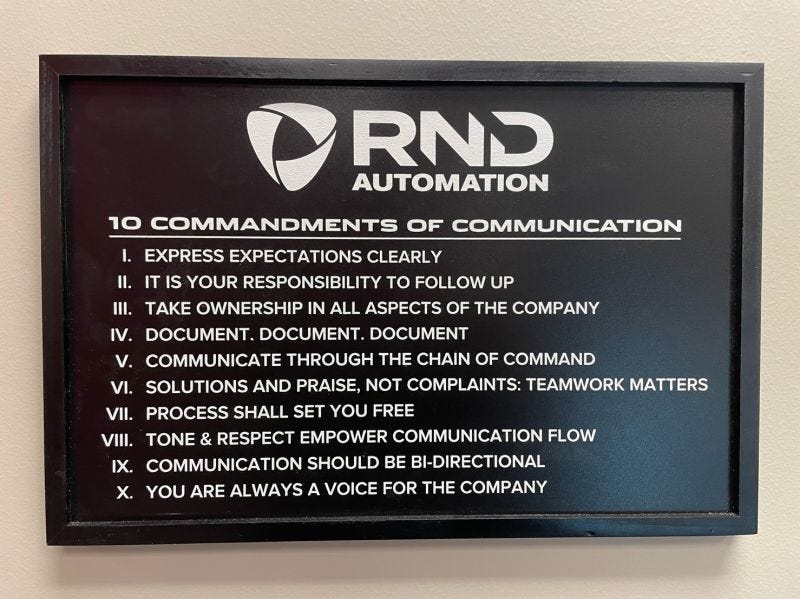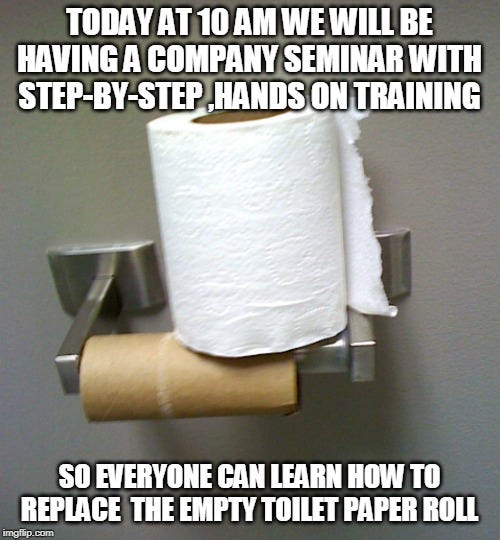The 10 Commandments of Communication
The biggest problem at most growing mid sized companies is communication ... and the fact that they don't think they have a communication problem.
Several years ago at RND Automation we had a communication problem…and we didn’t even know it. We were smaller then, maybe 30-40 people. How hard can it be to communicate in a group of that size? But working with our business coaches we discovered there were several things we were not doing to effectively communicate. So we decided to lay down some rules and hold each other accountable.
What we developed were the 10 Commandments of Communication.
Developed through several sessions with my management team, these were introduced to the company at a town hall meeting and then posted in several places around the offices and shops. The most important place was right above the TV in the main conference room. A great reminder to all when meetings went astray. In this article I’ll break them down and explain what they meant to us and how they helped communication in our organization.
I. EXPRESS EXPECTATIONS CLEARLY
How often have you heard “Get that to me as quick as you can?” or “I’ll get back to you shortly?” What does that even mean? When is “shortly” or “how quickly can you do this task”? You need to be clear on expectations. If you hear this ask… “so when can I expected to hear back from you?” Tomorrow? By what time? Never leave a conversation without knowing exactly when the deliverable is due.
Along the same lines define the deliverable. “When will the machine be finished"?” Define finished. Ready to ship? Ready to be crated? Ready to be loaded on the truck? Those are 3 very different things. You have to be clear about expectations.
II. IT IS YOUR RESPONSIBILITY TO FOLLOW UP
Nike had a famous principle: Your job isn’t done until the job is done. Just because you delivered on your expectation on time does not mean you move on and forget about it. It is your responsibility to ensure the person next in line understands what you did and has no further questions. If you are on the requesting side and the due date is fast approaching, reach out to the person delivering and ensure they are still on schedule. It’s not micro-managing to check in. Humans should not operate in silos. That is what kills communication and culture.
III. TAKE OWNERSHIP IN ALL ASPECTS OF THE COMPANY
Ask anyone at RND what got me the most angry and they would probably all agree…when I would walk into the bathroom and see empty toilet paper rolls or a sink with paper towels not in the trash. It became a bit of ajoke and we even created some memes about it that we posted on our Teams channels.
I was the President and I can’t tell you how many times I changed out paper towels or toilet paper or cleanup up the soap or water on the counter. Out in the shop if I found bolts on the ground I’d pick them up and place them back in the bins.
And while this is not verbal or written communication it is an illustrations that no matter what your function in the company, from the President to the least experienced assembler, your actions speak volumes.
IV. DOCUMENT. DOCUMENT. DOCUMENT.
Make sure that we record all important decisions, strategies, and outcomes. However don’t record just the successes. You must also record the failures for these are where you gain the most knowledge.
Documentation can take a lot of forms as well. The most obvious is writing and calculations. However you can also learn a lot from CAD models, code snippets, videos of machines or parts of machines and even just brainstorming notes logged in a documentation software such as Slack or Teams.
We began using Slack (then transformed to Teams) almost 7 years ago. The amount of data we generated in Teams was staggering (close to a GB a day). However we were also able to at an instant, to go back and search for that one gem of information.
We also make it a point to record and take a TON of photos of each and every machine we created. I see so many automation firms who have next to no records of their past machines. They are obviously important for marketing purposes but more so, going back to look at what the machine looked like when it left the shop when trying to diagnose something in the field (from afar).
V. COMMUNICATE THROUGH THE CHAIN OF COMMAND
I was told by my business coaches that from a leader “a whisper is a shout”. I never really got that for a long time. I finally came to the realization when I was casually talking with a few of the engineers about an idea I had on how to improve one of our machines. I never asked them to do anything. Just was brainstorming. A week later my Engineering Manager came to me and asked why his engineers were all working on this solution. I didn’t know. I admitted I brainstormed with them and said this would be a good improvement but never asked them to do it. He replied “You’re the President and owner. Of course they are going to do it.”
That’s when I realized. A whisper is indeed a shout. I should have gotten the EM involved in the brainstorm so he could remind the engineers that “we are just concepting here, we’re not doing the work yet.”
I see the ownership or other leaders in SMBs going around their subordinates all the time to get work done. Your managers can’t do their job if you are also giving their employees direction.
VI. SOLUTIONS AND PRAISE, NOT COMPLAINTS: TEAMWORK MATTERS
At RND we had a situation called a “solutionless encounter”. This is when someone comes to you with a problem or complaint but does not bring a possible solution to the table. We welcomed our employees to come to us when they were struggling or unhappy, but we expected them to have a possible solution as well. It may not be the ultimate solution, but it was a starting point.
We also reminded everyone that praise should be given publicly and criticism privately. Nothing kills teamwork more than dressing down an individual in front of others. And nothing raises morale more than recognizing their hard work in front of that same team.
VII. PROCESS SHALL SET YOU FREE
More of a “written communication” aspect but just as important. You MUST have processes. I would say “for everything” but that’s a tall order.
We had a flowchart on our conference room wall (and on our internal Wiki page) that had probably 100 flowchart icons that describes our process from “How do we find customers” to “How do we handle after sales and service” with all steps in between.
Each icon had associated procedures. Click on one and the work instructions opened. So if Jane who normally did the Sales Orders was out for some reason we could ask John to do it. All he had to do was open those instructions and he was off to the races.
And it was more than just clerical items. We described how to do FATs, how to do design reviews, the correct process for naming valves and I/O points, how to build HMI screens and much, much more.
Having processes takes the guesswork out of most tasks and allows you to not only be efficient, but also consistent. Write it down. Make it a set of rules and then enforce it.
VIII. TONE & RESPECT EMPOWER COMMUNICATION FLOW
I think this one is self explanatory but it’s still important. People will disagree in a company. People will get passionate. People (like me) will get upset when things are not progressing. However you can always express your anger, disappointment, conflicting opinion etc. in a respectful manner.
I always invited ANYONE at the company to come to me to discuss anything they wanted. I promised them I would always listen to their point of view and their opinions. At the end of the discussion I may or may not agree. And once I make my decision (even if it was contrary) I expected that we would “disagree but commit” and move on.
IX. COMMUNICATION SHOULD BE BIDIRECTIONAL
You need feedback both up and down the chain of command. Supervisors often give tasks and work to those that work under them. However these employees also need to give feedback to their supervisors. If you have been asked to get a task done by the end of the week, do not wait for your supervisor to come check on ou at 4PM on Friday before you tell them it’s not done. Speak to them on Thursdays and say
“I know I said I’d have this done by Friday but… (insert valid reasons here) … and I am going to do … (insert solution here) … to ensure it’s done by … (insert date here).”
X. YOU ARE ALWAYS A VOICE FOR THE COMPANY
When you are standing in line at the grocery store with your logoed polo on you are still a representative for the company. if you are rude to the cashier or cut someone off in the parking lot they will associate your company with that behaviour.
Furthermore your social media presence is a reflection of the company. It does not mean that you cannot have your own opinions but you must understand that those can have negative consequences. This is especially true when talking about hot topics like politics, violence, religion etc… Make sure you separate work and your personal opinions.
I hope that these 10 tips help to improve the communication at your company. Even if you just adopt 1 or 2 of them and really work on making sure everyone follows them you’d be surprised how much better things run.
The Automation Navigator is brought to you by Automation AMA, a company founded and run by an industry leader in assembly, robotics and packaging. Automation AMA offers a variety of services to help you on your automation journey or to help fine tune your engineering, sales, operations and business development departments. Learn more at www.autoamationAMA.com or shoot me a introductory email.





